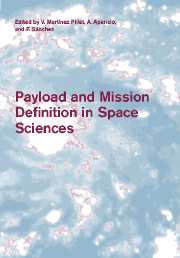Book contents
- Frontmatter
- Contents
- Preface
- Acknowledgements
- 1 The life cycle of an ESA science mission and how to get involved
- 2 Design issues for space science missions
- 3 Instrumentation in X-ray Astronomy
- 4 EUV and UV imaging and spectroscopy from space
- 5 The luminosity oscillations imager, a space instrument: from design to science
- 6 Hipparcos and Gaia: the development of space astrometry in Europe
- 7 Space Physics Instrumentation and Missions
- 8 Planetary observations and landers
5 - The luminosity oscillations imager, a space instrument: from design to science
Published online by Cambridge University Press: 19 October 2009
- Frontmatter
- Contents
- Preface
- Acknowledgements
- 1 The life cycle of an ESA science mission and how to get involved
- 2 Design issues for space science missions
- 3 Instrumentation in X-ray Astronomy
- 4 EUV and UV imaging and spectroscopy from space
- 5 The luminosity oscillations imager, a space instrument: from design to science
- 6 Hipparcos and Gaia: the development of space astrometry in Europe
- 7 Space Physics Instrumentation and Missions
- 8 Planetary observations and landers
Summary
The Luminosity Oscillations Imager (LOI) is a part of the VIRGO instrument aboard the Solar and Heliospheric Observatory (SOHO) launched on 2 December 1995. The main scientific objectives of the instrument were to detect solar g and p modes in intensity. The instrument is very simple. It consists of a telescope making an image of the Sun onto a silicon detector. This detector resolves the solar disk into 12 spatial elements allowing the detection of degrees lower than seven. The guiding is provided by two piezoelectric actuators that keep the Sun centred on the detector to better than 0.1″. The LOI serves here as an example for understanding the logical steps required for building a space instrument. The steps encompasses the initial scientific objectives, the conceptual design, the detailed design, the testing, the operations and the fulfilment of the initial scientific objectives. Each step is described in details for the LOI. The in-flight and ground-based performances, and the scientific achievements of the LOI are mentioned. When the loop is looped, it can be assessed whether a Next Generation LOI could be useful. This short course can serve as a guide when one wishes to propose a space instrument for a new space mission.
- Type
- Chapter
- Information
- Payload and Mission Definition in Space Sciences , pp. 185 - 218Publisher: Cambridge University PressPrint publication year: 2005
- 1
- Cited by



